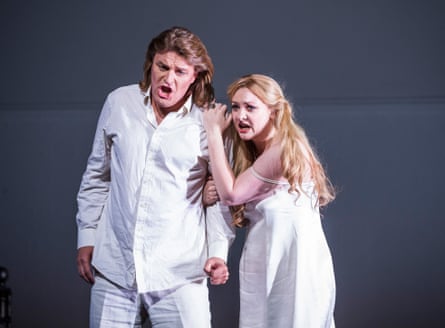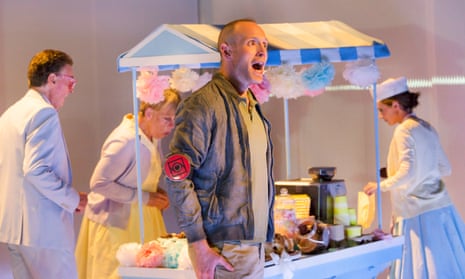A shy, buttoned-up Englishman and a charismatic, freely unbuttoned New Yorker: Benjamin Britten (1913-1976) and Leonard Bernstein (1918-1990) appear opposites until you place them side by side. This comparison illuminated the opening concerts – entitled Britten, Bernstein and America – of the 71st Aldeburgh festival, giving the chance for music of every mood, from Britten’s sombre orchestral work Sinfonia da Requiem to the show-stopping dazzle of Bernstein’s Glitter and Be Gay from his operetta Candide. There’s one obvious figure to vault these stylistic extremes: John Wilson, festival artist-in-residence, who conducted first the BBC Scottish Orchestra and then his own smaller, leaner, Broadway-style John Wilson Orchestra.
Britten and Bernstein each had careers as composers, conductors and pianists, but shared a more particular connection. Bernstein conducted the first US performance of Britten’s Peter Grimes in 1944 and featured work from it in his last concert as conductor, in 1990. The seeds of that opera were planted when the young Britten was in America, escaping wartime Britain. Works by the two composers were woven across three nights at Snape Maltings.
The BBC Scottish gave the world premiere of a sumptuous orchestration, by Colin Matthews, of Britten’s Seven Sonnets of Michelangelo. Britten wrote these love songs for his lifelong partner, the singer Peter Pears. With full orchestra (instead of piano) at his disposal, Matthews (b1946) caught the characteristic radiance, as well as the subdued mystery – especially in the muted third song – of Britten’s own orchestral voice. Robert Murray was the sensuous, much-cheered soloist.

Cédric Tiberghien made virtuosic sense of the solo piano part – not quite a concerto, but the instrument is jazzily prominent – in Bernstein’s Symphony No 2, The Age of Anxiety (1948-49). The following night another pianist, Pavel Kolesnikov, was a scintillating soloist in Britten’s underrated, oddly romantic Diversions for Piano Left Hand and Orchestra (1940). For the last of this trio of concerts, Wilson conducted songs from Bernstein musicals performed by a terrific lineup led by Kim Criswell, with the versatile Louise Alder (busy elsewhere in Mozart and Richard Strauss), Damian Humbley, Nadim Naaman. Classy and exuberant, the John Wilson Orchestra pumped up the energy.
The American theme continued, loosely, in Aldeburgh’s world premiere opera commission by Emily Howard (b1979). To See the Invisible is based on a story by the US sci-fi writer Robert Silverberg. In 11 scenes, with a cast of seven and a nine-strong ensemble (ace members of Birmingham Contemporary Music Group, conducted by Richard Baker), its subject is loneliness and paranoia. Nothing is explained, all (more or less) understood. A young man is convicted of a crime of “coldness” and sentenced to a year of “invisibility”, ostracised by the world. Howard’s menacing use of percussion and grainy-textured instrumental writing, variously monochrome and lush, capture the atmosphere.
Her evocative score embraces other composers: a lute song by John Dowland, sung in a brothel scene in which pleasure and pain are played out with clinical horror, and the opening of the trio Soave il Vento, from Mozart’s Così fan Tutte. In Howard’s reworking, it shifts to a noodling, candy-sweet marimba-dominated melody, representing a world of “warmth”. Cacti thrive and a couple indulge themselves in “bagels, cookies, muffins and cupcake, lemon and poppy seed, toffee and blueberry or double-choc-chip”. Try singing that. Ana Inés Jabares-Pita’s bright designs are fresh and effective.
The opera is the fruit of three years’ collaboration between Howard, the librettist Selma Dimitrijevic and the director Dan Ayling. It shows both the rewards of prolonged endeavour and the risk of getting so close to the material that no one can step back and say: “Just a minute…” Howard might now want to re-examine the pacing. Scenes repeat, some too often, and at times need tightening. Yet there is plenty to absorb us, especially in the superb performances of The Invisible by Nicholas Morris, a baritone who can also sing falsetto, and Anna Dennis as The Other Invisible, making leaps of a 10th sound as easy as breathing. The rest of the cast, and BCMG, give sterling performances.

The discovery of a new Wagnerian star – the Irish soprano Jennifer Davis, a late and bold replacement as Elsa von Brabant – made any qualms about the Royal Opera’s new staging of Wagner’s Lohengrin shrink into insignificance. Directed by David Alden and designed by Paul Steinberg with lighting by Adam Silverman, it plunders 20th-century imagery to at times cumbersome effect. Yet nothing, not even the bridal march being enacted in the front stalls or the Nuremberg-style swan-swastika-flags, detracts from the conducting of the Latvian Andris Nelsons, a youthful, Bayreuth veteran of this work. He leads a performance of zeal and authority, chorus and orchestra at their vigorous best, from whispered prelude to trumpets fanfaring on high or low brass blasting from the pit.
This opera, a stepping stone for Wagner to his mature works, demands a mighty voice in the title role. The experienced German heroic tenor, Klaus Florian Vogt, as the grail knight who arrives on a swan boat and whose name cannot be known, has the requisite vim. The reedy vehemence of his opening appearance gives no hint of the pure, floated pianissimo to come, some four hours later as he bids farewell. Christine Goerke was tempestuous and grim as the manipulative Ortrud, Thomas J Mayer a forceful partner in crime as Telramund, would-be Duke of Brabant. Listen on BBC Radio 3, 7 July.
Longborough, the family-run opera company in the Cotswolds, cannot match Royal Opera House standards but has established itself as a plucky training ground for Wagner, thanks to its regular conductor, Anthony Negus. Chorus and orchestra get better each year. The new Der Fliegende Holländer, directed by Thomas Guthrie, restricts itself to a simple cloudscape and Scandi-style fishing village set. Simon Thorpe (Dutchman) and a promising new name, Kirstin Sharpin as Senta – who bizarrely stabs herself instead of drowning – head a worthy cast, with Richard Wiegold a big-hearted Daland and William Wallace a fine young Steersman. Next year Longborough starts a new Ring cycle, its second. Once bitten, twice mad. Founders Martin and Lizzie Graham, who soon hand over the artistic reins to their daughter Polly Graham, would be the first to admit it. Good for them. Opera needs this kind of intrepid eccentricity.
Star ratings (out of 5)
The Aldeburgh festival ★★★★
Lohengrin ★★★★★
Der Fliegende Holländer ★★★★★

Comments (…)
Sign in or create your Guardian account to join the discussion